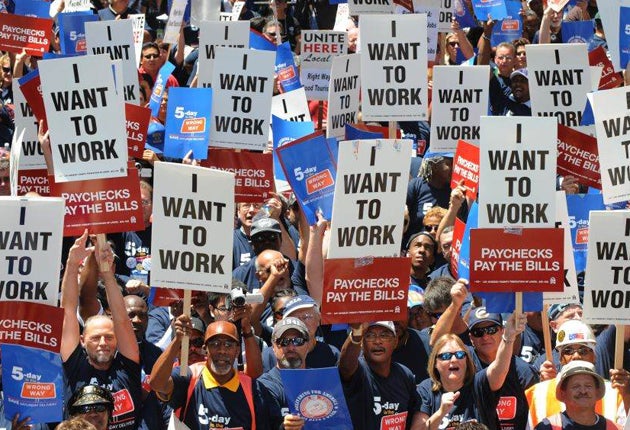US Fed turns taps back on with $600bn package of QE
Central bank to pump $75bn a month into the markets to stimulate economy

The Federal Reserve cranked its printing presses back into action, promising it would spend $600bn (£373bn) of newly minted money buying US government debt in an attempt to bring down interest rates and speed up the economic recovery.
The US central bank's Federal Open Market Committee said yesterday that "progress towards its objectives has been disappointingly slow", because unemployment remains high and inflation uncomfortably low in the world's largest economy.
In its long-awaited announcement on the resumption of quantitative easing last night, the Fed said that it will pump the new money into credit markets over the next eight months, at a rate of $75bn per month.
The recovery is simply not coming through fast enough, it said. "Household spending is increasing gradually, but remains constrained by high unemployment, modest income growth, lower housing wealth and tight credit. Business spending on equipment and software is rising, though less rapidly than earlier in the year. Employers remain reluctant to add to payrolls."
Quantitative easing (QE) is the central bank practice of printing new money and using it to buy bonds on the open market. It is designed to push market interest rates lower when traditional tools, such as official interest rates, have been exhausted. The Fed yesterday kept official rates in the rock-bottom range of zero to 0.25 per cent, where they have been since December 2008. It repeated that they would stay "exceptionally low ... for an extended period".
With Republicans having captured the House of Representatives in the midterm elections, on the back of public concern about government debt and spending, there is likely to be little scope for additional economic stimulus via fiscal policy. That puts the strain on monetary policy and on the Fed.
Ben Bernanke, the Fed's chairman, laid the groundwork for a new round of QE in speeches over recent months, citing persistently high unemployment and a weak housing market as a threat to the sustainability of the economic recovery. Under the first QE programme, launched at the apex of the credit crisis, the Fed bought $1.7 trillion of US government debt and mortgage-related securities, designed to bring down the cost of borrowing for homebuyers and businesses. It promised yesterday that interest on those investments, and income it gets when the bonds are repaid, will be used to augment the new QE programme.
Adding the new and continuing programmes together, the Fed expects to buy $850bn-$900bn of Treasuries between now and the end of June 2011.
Jeff Kleintop, the chief market strategist at LPL Financial, said the size of the new money was a little ahead of Wall Street's estimates.
"The gap between disappointment and surprise is so narrow, but I think they may have threaded that gap," he said. "This provides the market with additional clarity. It now knows the size of the purchases, how long they're going to take place and the pace at which the Fed is going to conduct it. The question is whether this is enough." The Fed concluded its two-day monetary policy meeting against the backdrop of better than expected economic data yesterday.
The service sector, which employs 80 per cent of American workers, expanded for the 10th consecutive month, according to the Institute of Supply Managers survey. Orders for manufactured goods were up 2.1 per cent in September, after being flat in August.
A survey of private sector employees, by the payroll processing company ADP, suggested they created 43,000 jobs in October, twice as many as Wall Street had predicted.
Subscribe to Independent Premium to bookmark this article
Want to bookmark your favourite articles and stories to read or reference later? Start your Independent Premium subscription today.

Join our commenting forum
Join thought-provoking conversations, follow other Independent readers and see their replies